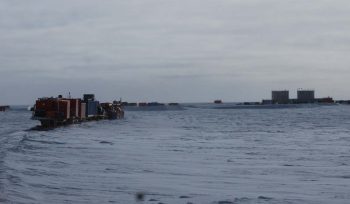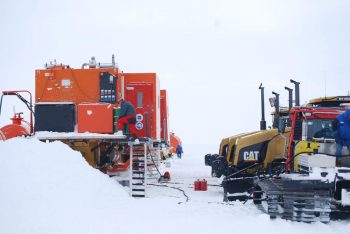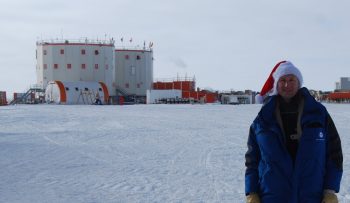Didier Schmitt is a member of the space Task Force at the European External Action Service. He is a regular opinion writer in major newspapers and magazines and has published a book on foresight. He will be contributing to this blog during his visit to Concordia – we join him as he arrives at Concordia after an 11-day supply trek in a tractor-caravan:
We arrive on top of Dome C and my GPS indicates 3271 m altitude. A few minutes after we passed the 75th parallel our scout vehicle informs us by radio that they see the two towers. A few minutes later I can distinguish the can-shaped structures; they appear grey on a white horizon.
We are 17 km from the target and that still means a 90-minute drive. As we come closer it reminds me of Star Wars, when the spaceship lands on the desert world of Tatooine where Anakin Skywalker lives. The inhabitants of Concordia are eager to meet us. Some come to us with skidoos and others are taking pictures or film our arrival while the convoy carefully enters the huge parking area. There are only two to three raid arrivals a year and we bring much-awaited supplies. I see a few familiar faces from the Astrolabe ship, they came here by plane. We hug like friends who have not seen each other for years! One face is more familiar: Carole Dangoisse, the ESA medical doctor who will stay on the base for the next 12 months. She is in charge of implementing a dozen health science experiments. An activity started under the ESA Aurora programme in 2005.
This Raid took 11 days and we are relieved to have had no major mechanical breakdowns and we are all safe. Refuelling and mechanical check-up is left for the next day. For the time-being it is time to celebrate. The station is much bigger than I imagined. The towers are built on huge pillars three stories high. Nine flags are visible on the top, meaning that eight nations are present: Canada, Belgium (that is me), France, Germany, Italy, Japan, UK, and USA. The ninth is the EU flag! The entrance is in the middle of the two towers: it is a big freezer door – except that you get out of the freezer, not into it…
First thing is to get rid of the winter coat layers. To the right there is the ‘noisy tower’, hosting the life support systems. Its water recycling system has been designed and tested over 10 years ago by the team of Christophe Lasseur at ESA’s technical heart ESTEC in The Netherlands! To the left there is the ‘quiet tower’: dorms, gym, labs, IT support and ‘control post’.
I have done a few extreme activities up to now, such as parabolic flights (weightlessness) or a 300 m deep dive in a mini-submarine. By the very nature of our ‘space work’ at ESA we are used to do fascinating stuff in various places. But this ‘bottom of the world’ endeavour is definitely the utmost for me. It is a fantastic and inspirational experience, like floating in time and space.
Concordia station is the most remote place on earth. In winter temperatures go down to -85°C and during 100 days you cannot see the sun. The location has been chosen because underneath is nearly 3500 m of ice that hide remarkable secrets. I am eager to discover all facets of this fascinating planet.







Discussion: no comments